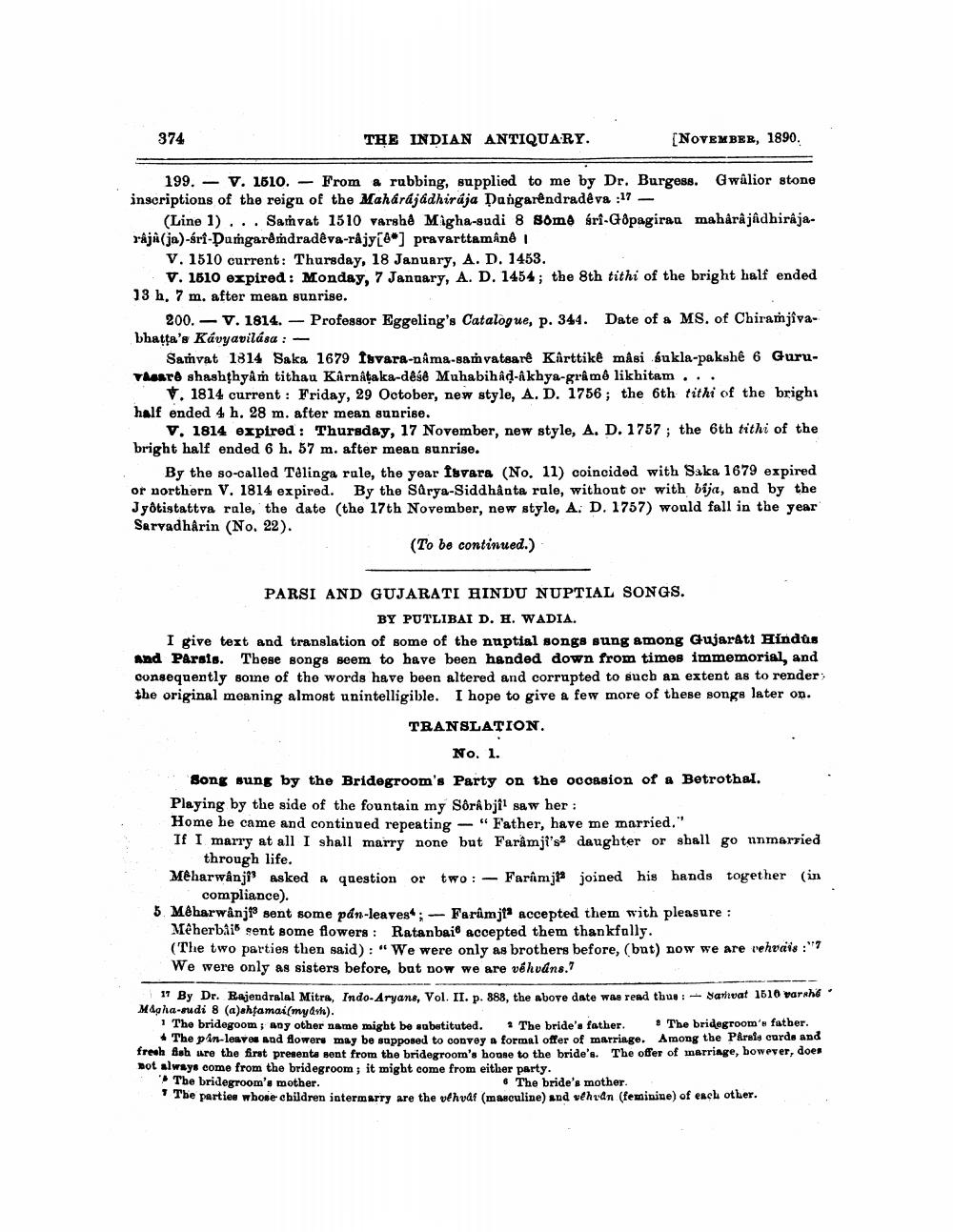________________
374
THE INDIAN ANTIQUARY.
[NOVEMBER, 1890.
199. - V. 1510. - From rubbing, supplied to me by Dr. Burgess. Gwalior stone inscriptions of the reign of the Maharajadhiraja Dangarendradeva :17 -
(Line 1) ... Samvat 1510 varshe Migha-gudi 8 soms sri-Gopagiran mahårâ jîdhirajarája (jo)-sri-Damgarêmdradêva-rajy[") pravarttamane i
V. 1510 current: Thursday, 18 January, A. D. 1453.
V. 1510 expired: Monday, 7 January, A. D. 1454; the 8th tithi of the bright half ended 13 h, 7 m. after mean sunrise.
200.- V. 1814. - Professor Eggeling's Catalogue, p. 344. Date of a MS. of Chiramjîvabhatta's Kávyavilása: -
Satvat 1814 Saka 1679 Isvara-nama-saṁvatsarê Karttike mâsi sukla-pakshe 6 GuruVaard shashthyÂm tithau Karnataka-dêsê Muhabihad-Akhya-gramô likhitam...
. 1814 current: Friday, 29 October, new style, A.D. 1756; the 6th tithi of the bright half ended 4 h. 28 m. after mean sunrise.
V. 1814 expired: Thursday, 17 November, new style, A. D. 1757 ; the 6th tithi of the bright half ended 6 h. 57 m. after mean sunrise.
By the so-called Telinga rule, the year Isvara (No. 11) coincided with Saka 1679 expired or northern V. 1814 expired. By the Sûrya-Siddhanta rale, without or with bija, and by the Jyotistattva rale, the date (the 17th November, new style, A. D. 1757) would fall in the year Sarvadhárin (No. 22).
(To be continued.)
PARSI AND GUJARATI HINDU NUPTIAL SONGS.
BY PUTLIBAI D. H. WADIA. I give text and translation of some of the nuptial songs sung among Gujarati Hindus And Parsis. These songs seem to have been handed down from times immemorial, and consequently some of the words have been altered and corrupted to such an extent as to render the original meaning almost unintelligible. I hope to give a few more of these songs later on.
TRANSLATION
No. 1. Bong sung by the Bridegroom's Party on the occasion of a Betrothal. Playing by the side of the fountain my Sôrábjil saw her: Home be came and continued repeating " Father, have me married." If I marry at all I shall marry none but Faramjis daughter or shall go unmarried
through life. Méharwanjis asked a question or two: - Faramjf joined his hands together in
compliance). 3. Mêharwânji sent some pán-leaves; - Farâmjta accepted them with pleasure :
Meherbiis sent some flowers: Ratanbai accepted them thankfully. (The two parties then said): "We were only as brothers before, (bat) now we are vehvais :"> We were only as sisters before, but now we are véhvans.?
17 By Dr. Rajendralal Mitra, Indo-Aryane, Vol. II. p. 888, the above date was read thus : Sarhuat 1610 var hl Magha-sudi 8 (a)ahtamaimydre).
The bridegroom any other name might be substituted. The bride's father. The bridegroom's futber.
The pin-leaves and flowers may be supposed to convey a formal offer of marriage. Among the PArals cards and fresh fish are the first presenta sont from the bridegroom's house to the bride's. The offer of marriage, bowever, doen not always come from the bridegroom; it might come from either party. The bridegroom's mother.
The bride's mother. e parties whose children intermarry are the vehvúi (masculine) and vehran (feminine) of each other.




